Abstract
Duchenne muscular dystrophy is one of the most common lethal monogenic disorders and is caused by dystrophin deficiency. The disease is transmitted as an X-linked recessive trait; however, recent biochemical and clinical studies have shown that many girls and women with a primary myopathy have an underlying dystrophinopathy, despite a negative family history for Duchenne dystrophy. These isolated female dystrophinopathy patients carried ambiguous diagnoses with presumed autosomal recessive inheritance (limbgirdle muscular dystrophy) prior to biochemical detection of dystrophin abnormalities in their muscle biopsy. It has been assumed that these female dystrophinopathy patients are heterozygous carriers who show preferential inactivation of the X chromosome harboring the normal dystrophin gene, although this has been shown for only a few X:autosome translocations and for two cases of discordant monozygotic twin female carriers. Here we study X-inactivation patterns of 13 female dystrophinopathy patients—10 isolated cases and 3 cases with a positive family history for Duchenne dystrophy in males. We show that all cases have skewed X-inactivation patterns in peripheral blood DNA. Of the nine isolated cases informative in our assay, eight showed inheritance of the dystrophin gene mutation from the paternal germ line. Only a single case showed maternal inheritance. The 10-fold higher incidence of paternal transmission of dystrophin gene mutations in these cases is at 30-fold variance with Bayesian predictions and gene mutation rates. Thus, our results suggest some mechanistic interaction between new dystrophin gene mutations, paternal inheritance, and skewed X inactivation. Our results provide both empirical risk data and a molecular diagnostic test method, which permit genetic counseling and prenatal diagnosis of this new category of patients.
Full text
PDF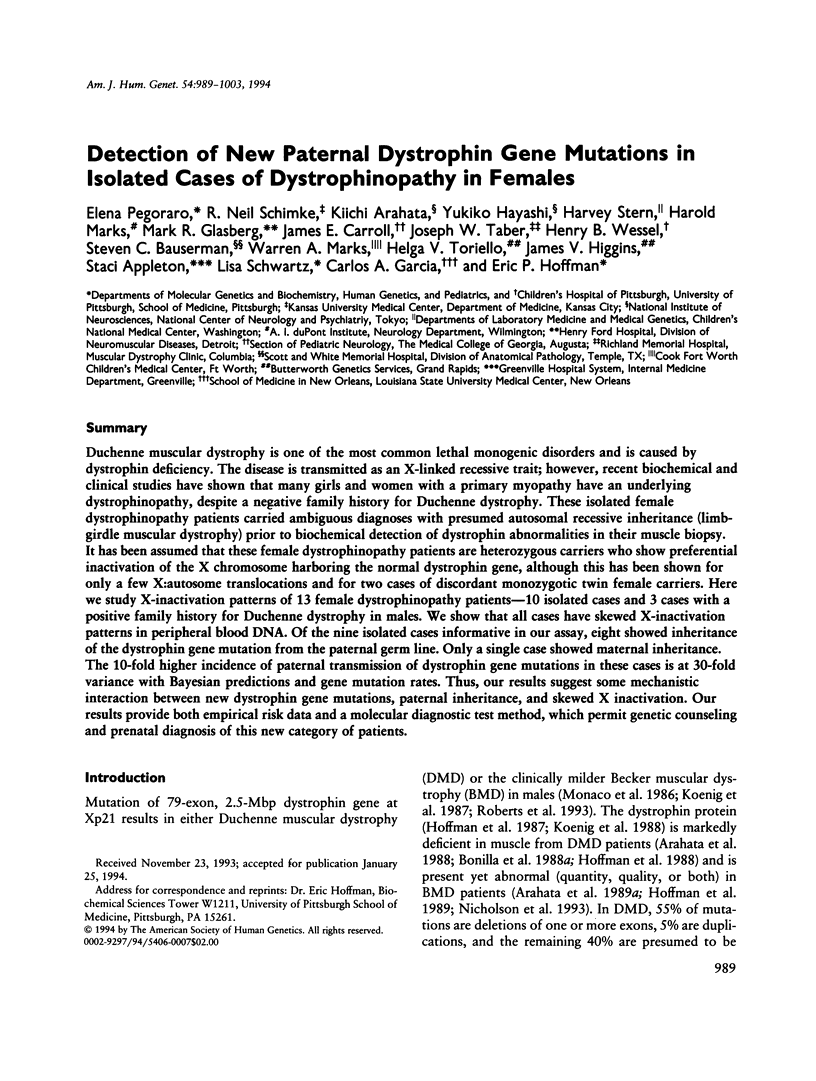
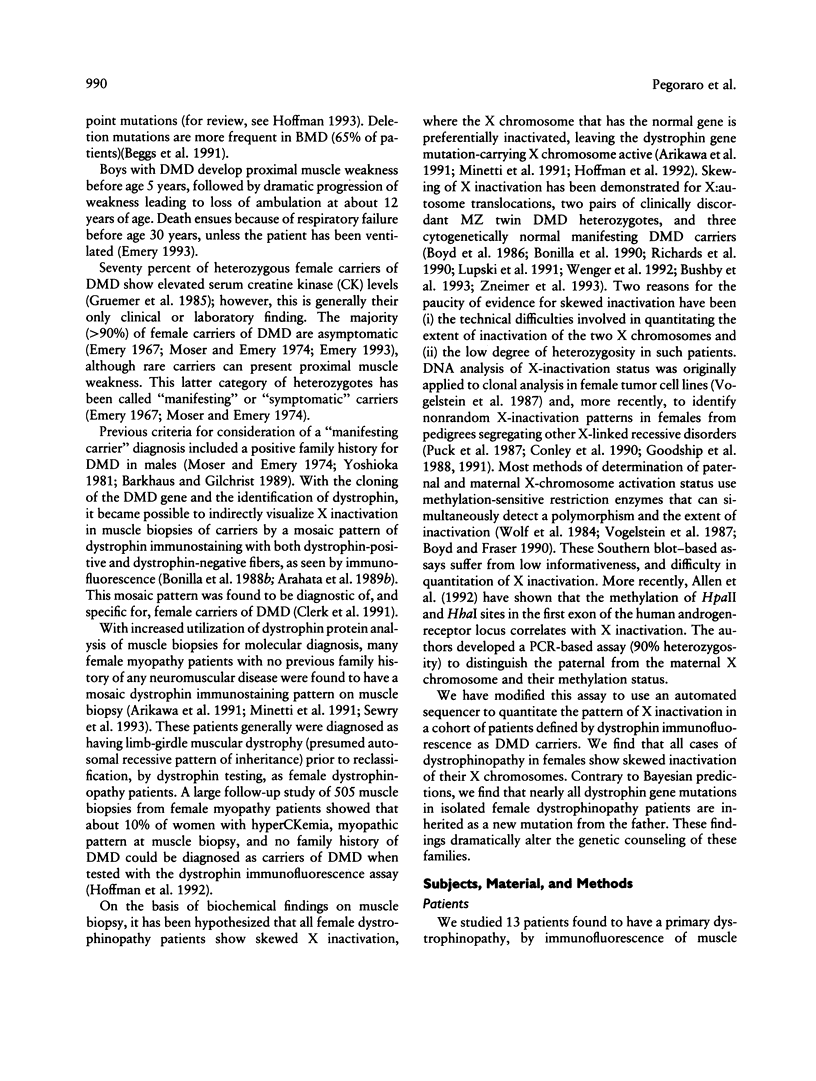
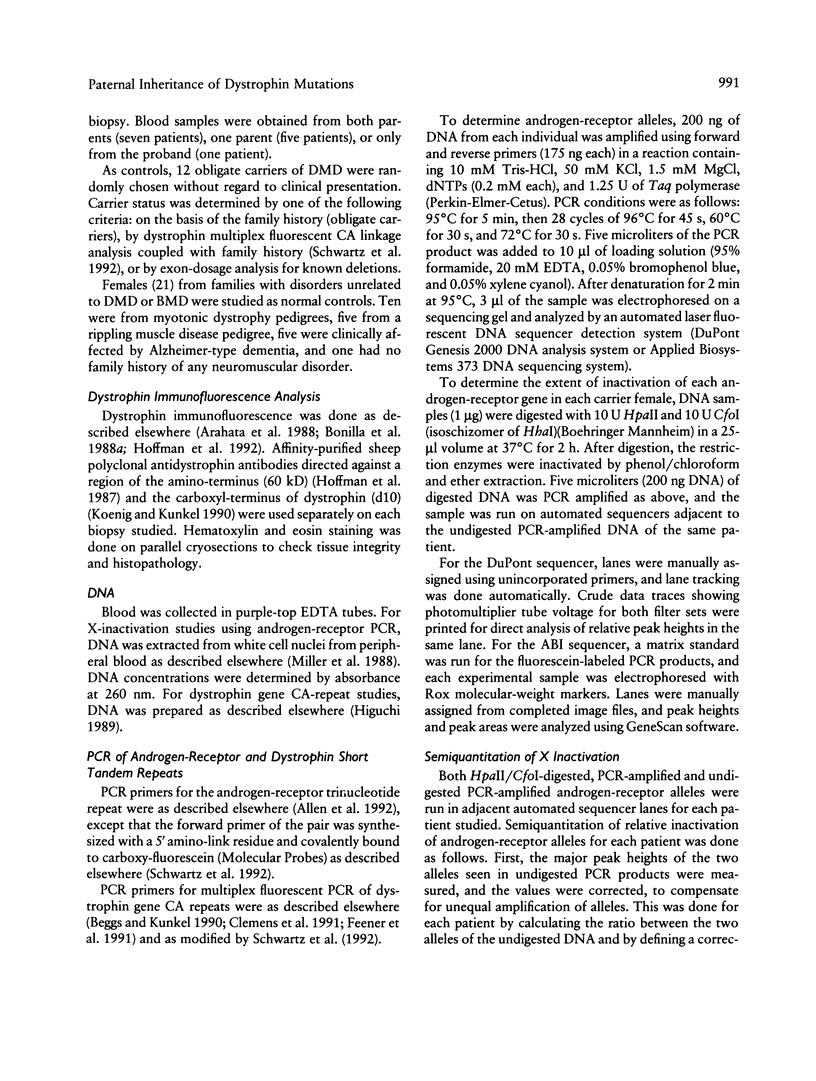
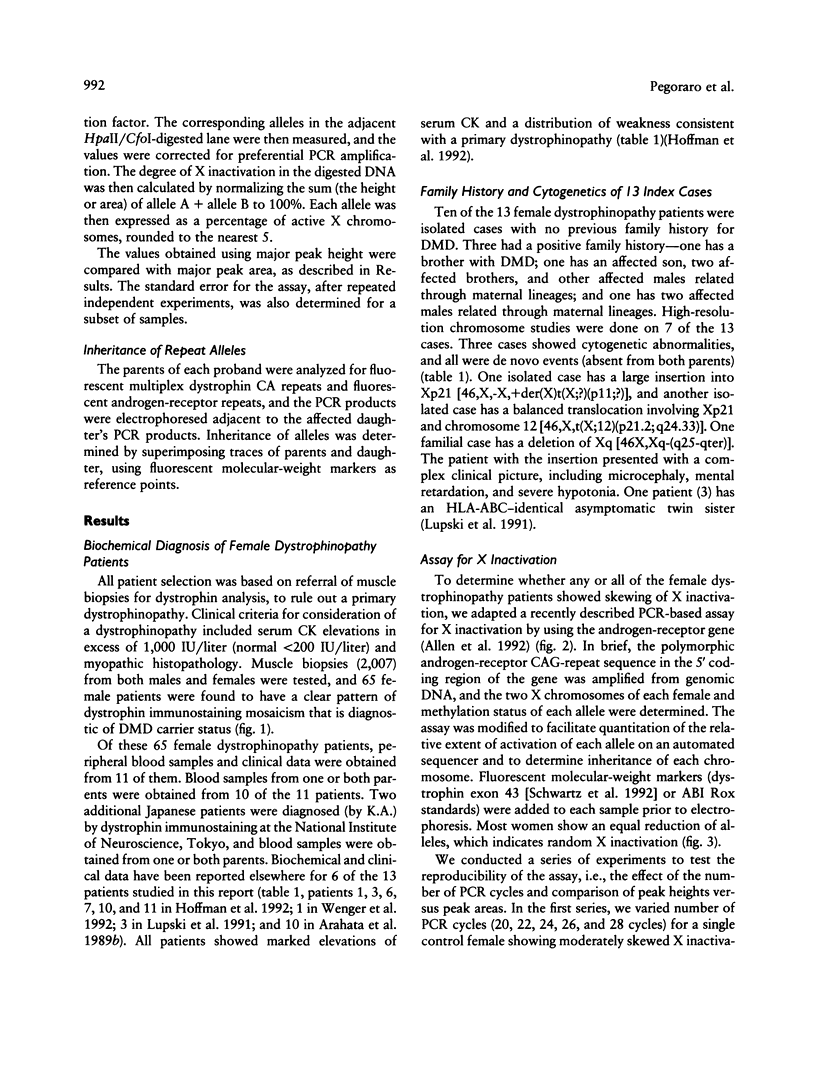
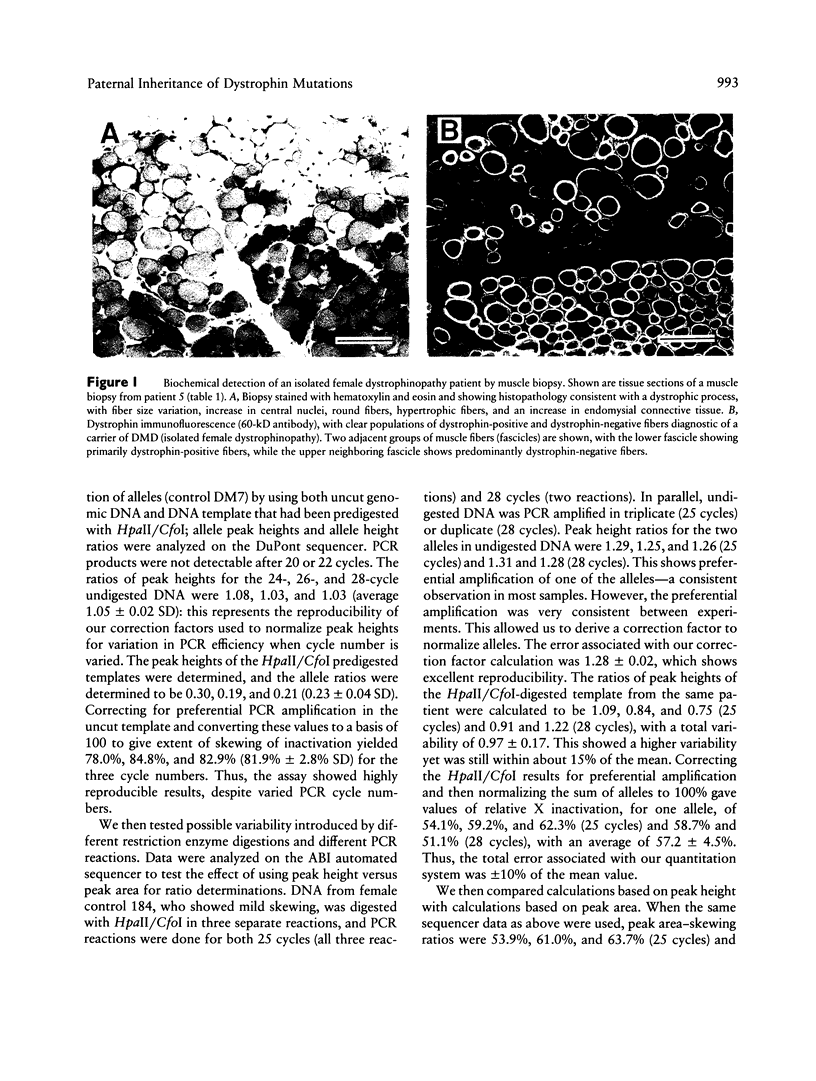
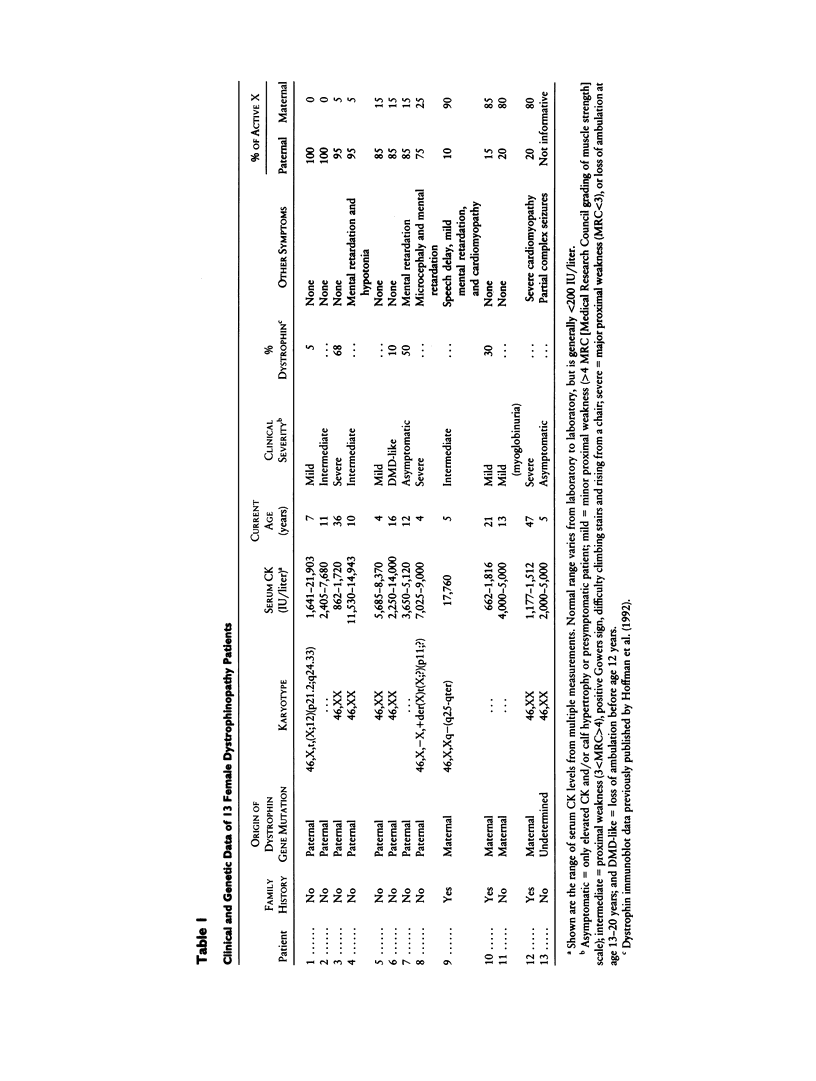
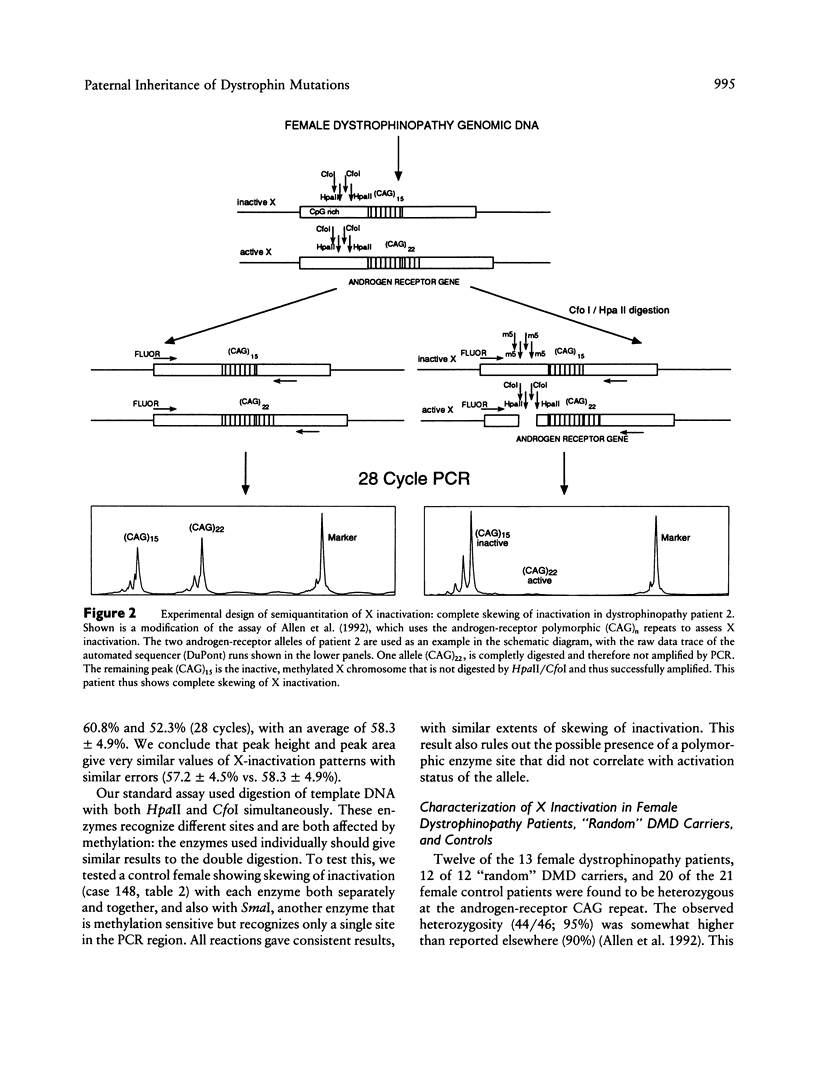
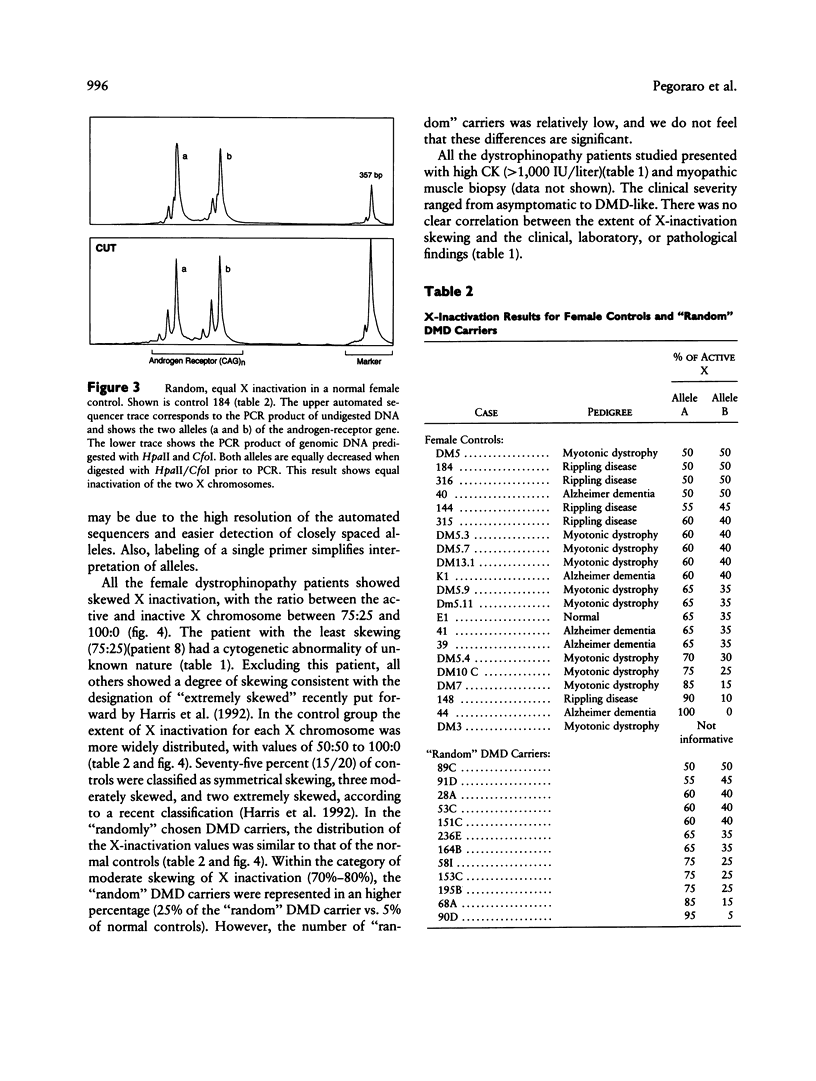
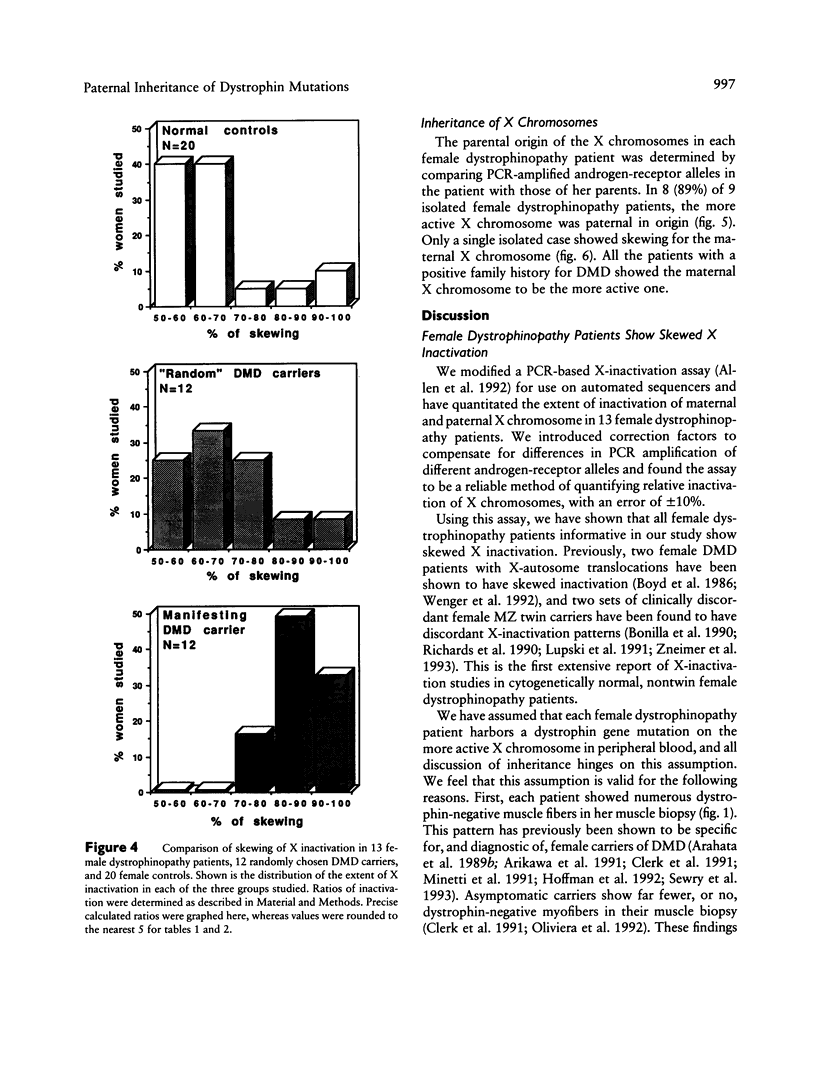
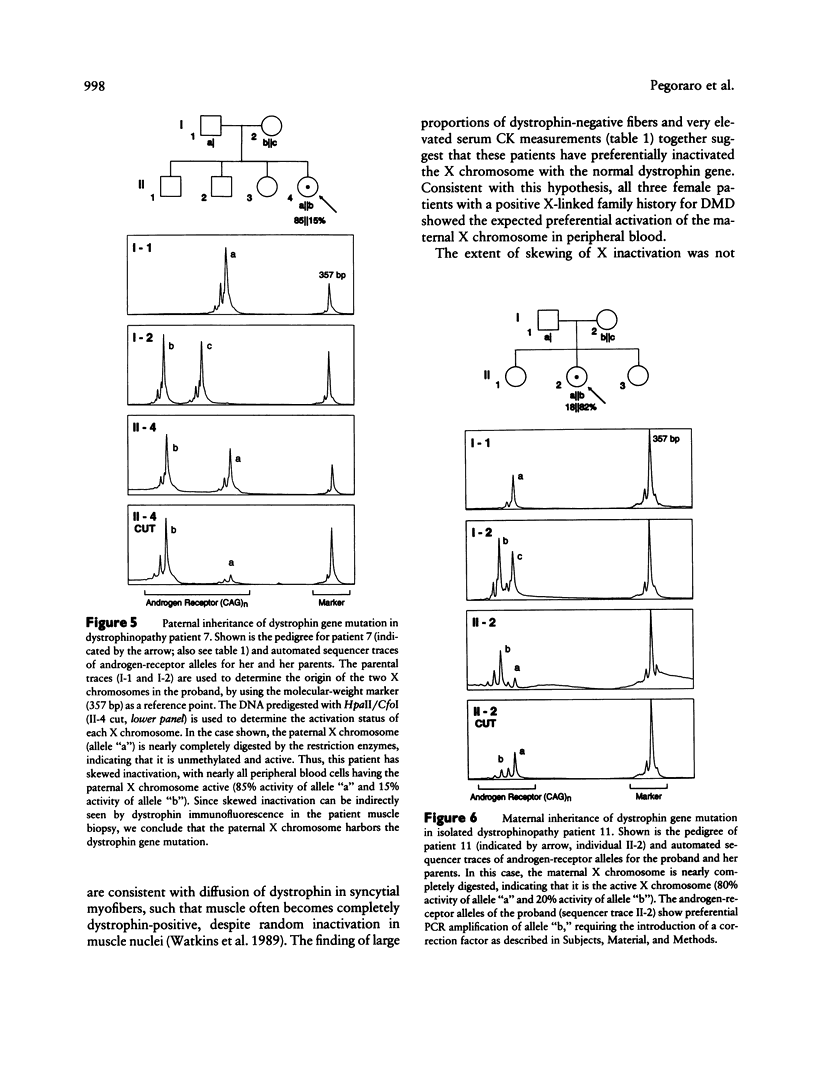
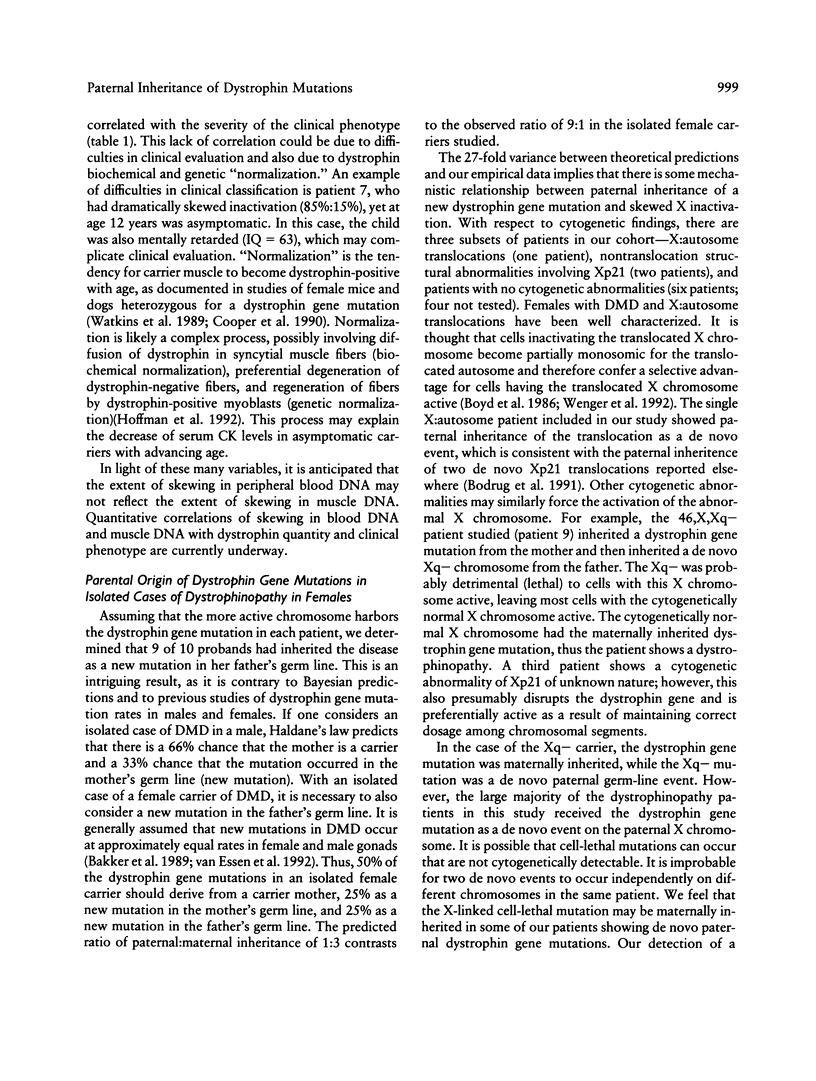
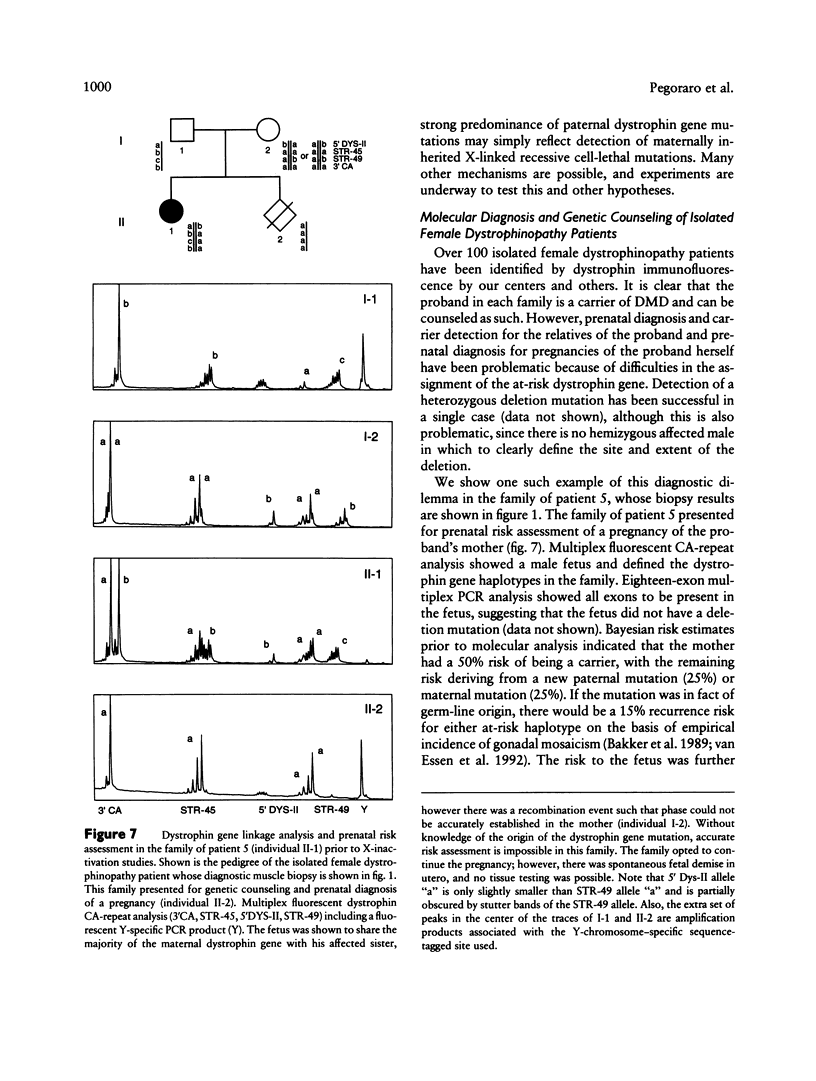
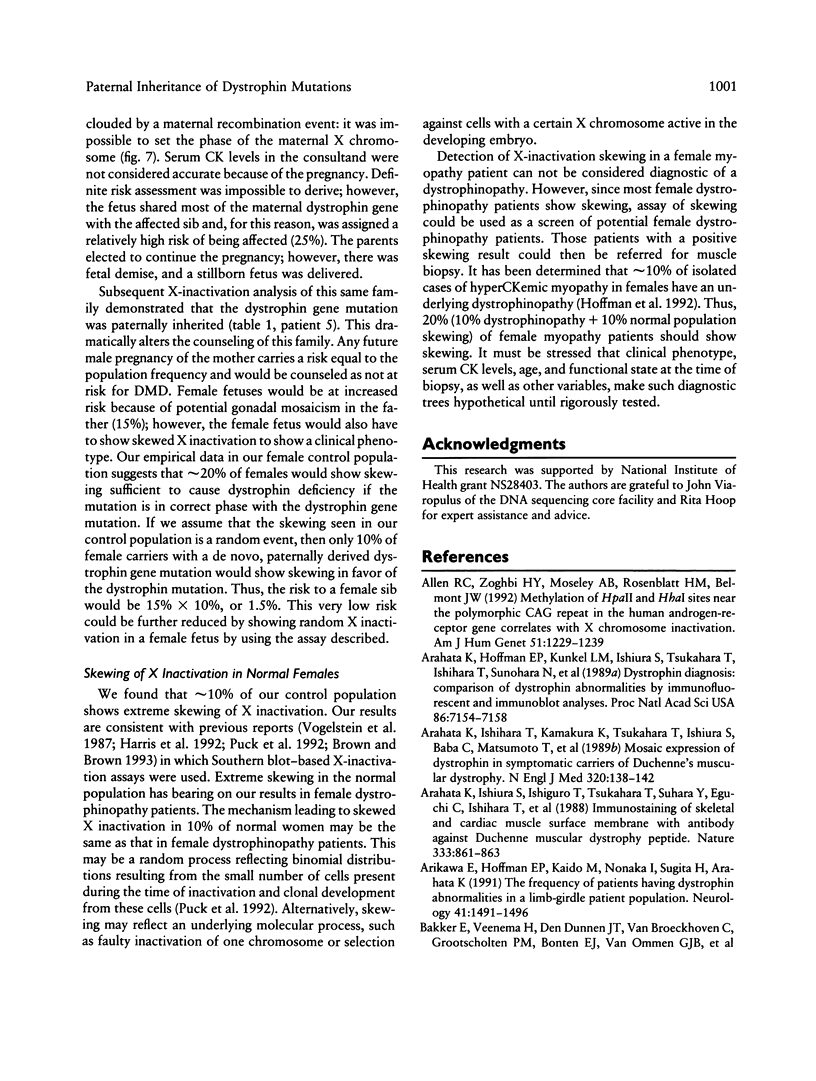
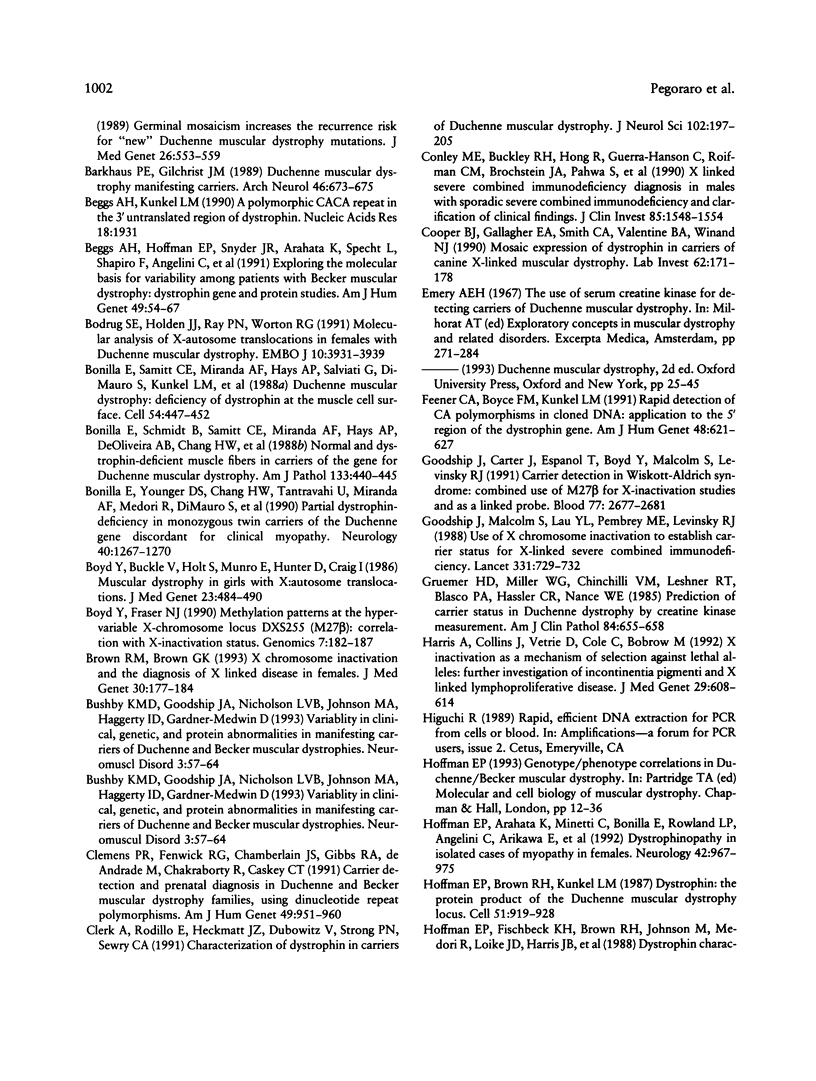
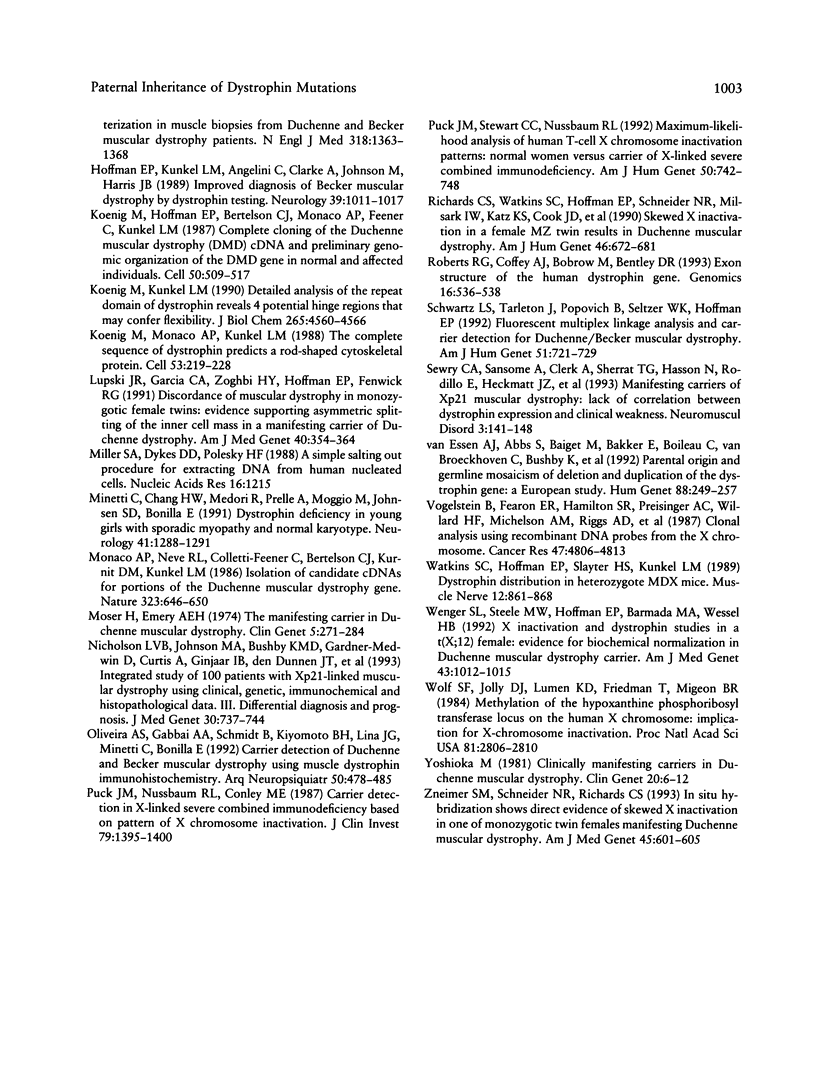
Images in this article
Selected References
These references are in PubMed. This may not be the complete list of references from this article.
- Allen R. C., Zoghbi H. Y., Moseley A. B., Rosenblatt H. M., Belmont J. W. Methylation of HpaII and HhaI sites near the polymorphic CAG repeat in the human androgen-receptor gene correlates with X chromosome inactivation. Am J Hum Genet. 1992 Dec;51(6):1229–1239. [PMC free article] [PubMed] [Google Scholar]
- Arahata K., Hoffman E. P., Kunkel L. M., Ishiura S., Tsukahara T., Ishihara T., Sunohara N., Nonaka I., Ozawa E., Sugita H. Dystrophin diagnosis: comparison of dystrophin abnormalities by immunofluorescence and immunoblot analyses. Proc Natl Acad Sci U S A. 1989 Sep;86(18):7154–7158. doi: 10.1073/pnas.86.18.7154. [DOI] [PMC free article] [PubMed] [Google Scholar]
- Arahata K., Ishihara T., Kamakura K., Tsukahara T., Ishiura S., Baba C., Matsumoto T., Nonaka I., Sugita H. Mosaic expression of dystrophin in symptomatic carriers of Duchenne's muscular dystrophy. N Engl J Med. 1989 Jan 19;320(3):138–142. doi: 10.1056/NEJM198901193200302. [DOI] [PubMed] [Google Scholar]
- Arahata K., Ishiura S., Ishiguro T., Tsukahara T., Suhara Y., Eguchi C., Ishihara T., Nonaka I., Ozawa E., Sugita H. Immunostaining of skeletal and cardiac muscle surface membrane with antibody against Duchenne muscular dystrophy peptide. Nature. 1988 Jun 30;333(6176):861–863. doi: 10.1038/333861a0. [DOI] [PubMed] [Google Scholar]
- Arikawa E., Hoffman E. P., Kaido M., Nonaka I., Sugita H., Arahata K. The frequency of patients with dystrophin abnormalities in a limb-girdle patient population. Neurology. 1991 Sep;41(9):1491–1496. doi: 10.1212/wnl.41.9.1491. [DOI] [PubMed] [Google Scholar]
- Barkhaus P. E., Gilchrist J. M. Duchenne muscular dystrophy manifesting carriers. Arch Neurol. 1989 Jun;46(6):673–675. doi: 10.1001/archneur.1989.00520420093029. [DOI] [PubMed] [Google Scholar]
- Beggs A. H., Hoffman E. P., Snyder J. R., Arahata K., Specht L., Shapiro F., Angelini C., Sugita H., Kunkel L. M. Exploring the molecular basis for variability among patients with Becker muscular dystrophy: dystrophin gene and protein studies. Am J Hum Genet. 1991 Jul;49(1):54–67. [PMC free article] [PubMed] [Google Scholar]
- Beggs A. H., Kunkel L. M. A polymorphic CACA repeat in the 3' untranslated region of dystrophin. Nucleic Acids Res. 1990 Apr 11;18(7):1931–1931. doi: 10.1093/nar/18.7.1931. [DOI] [PMC free article] [PubMed] [Google Scholar]
- Bodrug S. E., Holden J. J., Ray P. N., Worton R. G. Molecular analysis of X-autosome translocations in females with Duchenne muscular dystrophy. EMBO J. 1991 Dec;10(12):3931–3939. doi: 10.1002/j.1460-2075.1991.tb04963.x. [DOI] [PMC free article] [PubMed] [Google Scholar]
- Bonilla E., Samitt C. E., Miranda A. F., Hays A. P., Salviati G., DiMauro S., Kunkel L. M., Hoffman E. P., Rowland L. P. Duchenne muscular dystrophy: deficiency of dystrophin at the muscle cell surface. Cell. 1988 Aug 12;54(4):447–452. doi: 10.1016/0092-8674(88)90065-7. [DOI] [PubMed] [Google Scholar]
- Bonilla E., Schmidt B., Samitt C. E., Miranda A. F., Hays A. P., de Oliveira A. B., Chang H. W., Servidei S., Ricci E., Younger D. S. Normal and dystrophin-deficient muscle fibers in carriers of the gene for Duchenne muscular dystrophy. Am J Pathol. 1988 Dec;133(3):440–445. [PMC free article] [PubMed] [Google Scholar]
- Bonilla E., Younger D. S., Chang H. W., Tantravahi U., Miranda A. F., Medori R., DiMauro S., Warburton D., Rowland L. P. Partial dystrophin deficiency in monozygous twin carriers of the Duchenne gene discordant for clinical myopathy. Neurology. 1990 Aug;40(8):1267–1270. doi: 10.1212/wnl.40.8.1267. [DOI] [PubMed] [Google Scholar]
- Boyd Y., Buckle V., Holt S., Munro E., Hunter D., Craig I. Muscular dystrophy in girls with X;autosome translocations. J Med Genet. 1986 Dec;23(6):484–490. doi: 10.1136/jmg.23.6.484. [DOI] [PMC free article] [PubMed] [Google Scholar]
- Boyd Y., Fraser N. J. Methylation patterns at the hypervariable X-chromosome locus DXS255 (M27 beta): correlation with X-inactivation status. Genomics. 1990 Jun;7(2):182–187. doi: 10.1016/0888-7543(90)90539-7. [DOI] [PubMed] [Google Scholar]
- Brown R. M., Brown G. K. X chromosome inactivation and the diagnosis of X linked disease in females. J Med Genet. 1993 Mar;30(3):177–184. doi: 10.1136/jmg.30.3.177. [DOI] [PMC free article] [PubMed] [Google Scholar]
- Bushby K. M., Goodship J. A., Nicholson L. V., Johnson M. A., Haggerty I. D., Gardner-Medwin D. Variability in clinical, genetic and protein abnormalities in manifesting carriers of Duchenne and Becker muscular dystrophy. Neuromuscul Disord. 1993 Jan;3(1):57–64. doi: 10.1016/0960-8966(93)90042-i. [DOI] [PubMed] [Google Scholar]
- Clemens P. R., Fenwick R. G., Chamberlain J. S., Gibbs R. A., de Andrade M., Chakraborty R., Caskey C. T. Carrier detection and prenatal diagnosis in Duchenne and Becker muscular dystrophy families, using dinucleotide repeat polymorphisms. Am J Hum Genet. 1991 Nov;49(5):951–960. [PMC free article] [PubMed] [Google Scholar]
- Clerk A., Rodillo E., Heckmatt J. Z., Dubowitz V., Strong P. N., Sewry C. A. Characterisation of dystrophin in carriers of Duchenne muscular dystrophy. J Neurol Sci. 1991 Apr;102(2):197–205. doi: 10.1016/0022-510x(91)90069-j. [DOI] [PubMed] [Google Scholar]
- Conley M. E., Buckley R. H., Hong R., Guerra-Hanson C., Roifman C. M., Brochstein J. A., Pahwa S., Puck J. M. X-linked severe combined immunodeficiency. Diagnosis in males with sporadic severe combined immunodeficiency and clarification of clinical findings. J Clin Invest. 1990 May;85(5):1548–1554. doi: 10.1172/JCI114603. [DOI] [PMC free article] [PubMed] [Google Scholar]
- Cooper B. J., Gallagher E. A., Smith C. A., Valentine B. A., Winand N. J. Mosaic expression of dystrophin in carriers of canine X-linked muscular dystrophy. Lab Invest. 1990 Feb;62(2):171–178. [PubMed] [Google Scholar]
- Feener C. A., Boyce F. M., Kunkel L. M. Rapid detection of CA polymorphisms in cloned DNA: application to the 5' region of the dystrophin gene. Am J Hum Genet. 1991 Mar;48(3):621–627. [PMC free article] [PubMed] [Google Scholar]
- Goodship J., Carter J., Espanol T., Boyd Y., Malcolm S., Levinsky R. J. Carrier detection in Wiskott-Aldrich syndrome: combined use of M27 beta for X-inactivation studies and as a linked probe. Blood. 1991 Jun 15;77(12):2677–2681. [PubMed] [Google Scholar]
- Goodship J., Malcolm S., Lau Y. L., Pembrey M. E., Levinsky R. J. Use of X chromosome inactivation analysis to establish carrier status for X-linked severe combined immunodeficiency. Lancet. 1988 Apr 2;1(8588):729–732. doi: 10.1016/s0140-6736(88)91537-1. [DOI] [PubMed] [Google Scholar]
- Gruemer H. D., Miller W. G., Chinchilli V. M., Leshner R. T., Blasco P. A., Hassler C. R., Nance W. E. Prediction of carrier status in Duchenne dystrophy by creatine kinase measurement. Am J Clin Pathol. 1985 Nov;84(5):655–658. doi: 10.1093/ajcp/84.5.655. [DOI] [PubMed] [Google Scholar]
- Harris A., Collins J., Vetrie D., Cole C., Bobrow M. X inactivation as a mechanism of selection against lethal alleles: further investigation of incontinentia pigmenti and X linked lymphoproliferative disease. J Med Genet. 1992 Sep;29(9):608–614. doi: 10.1136/jmg.29.9.608. [DOI] [PMC free article] [PubMed] [Google Scholar]
- Hoffman E. P., Arahata K., Minetti C., Bonilla E., Rowland L. P. Dystrophinopathy in isolated cases of myopathy in females. Neurology. 1992 May;42(5):967–975. doi: 10.1212/wnl.42.5.967. [DOI] [PubMed] [Google Scholar]
- Hoffman E. P., Brown R. H., Jr, Kunkel L. M. Dystrophin: the protein product of the Duchenne muscular dystrophy locus. Cell. 1987 Dec 24;51(6):919–928. doi: 10.1016/0092-8674(87)90579-4. [DOI] [PubMed] [Google Scholar]
- Hoffman E. P., Fischbeck K. H., Brown R. H., Johnson M., Medori R., Loike J. D., Harris J. B., Waterston R., Brooke M., Specht L. Characterization of dystrophin in muscle-biopsy specimens from patients with Duchenne's or Becker's muscular dystrophy. N Engl J Med. 1988 May 26;318(21):1363–1368. doi: 10.1056/NEJM198805263182104. [DOI] [PubMed] [Google Scholar]
- Hoffman E. P., Kunkel L. M., Angelini C., Clarke A., Johnson M., Harris J. B. Improved diagnosis of Becker muscular dystrophy by dystrophin testing. Neurology. 1989 Aug;39(8):1011–1017. doi: 10.1212/wnl.39.8.1011. [DOI] [PubMed] [Google Scholar]
- Koenig M., Hoffman E. P., Bertelson C. J., Monaco A. P., Feener C., Kunkel L. M. Complete cloning of the Duchenne muscular dystrophy (DMD) cDNA and preliminary genomic organization of the DMD gene in normal and affected individuals. Cell. 1987 Jul 31;50(3):509–517. doi: 10.1016/0092-8674(87)90504-6. [DOI] [PubMed] [Google Scholar]
- Koenig M., Kunkel L. M. Detailed analysis of the repeat domain of dystrophin reveals four potential hinge segments that may confer flexibility. J Biol Chem. 1990 Mar 15;265(8):4560–4566. [PubMed] [Google Scholar]
- Koenig M., Monaco A. P., Kunkel L. M. The complete sequence of dystrophin predicts a rod-shaped cytoskeletal protein. Cell. 1988 Apr 22;53(2):219–228. doi: 10.1016/0092-8674(88)90383-2. [DOI] [PubMed] [Google Scholar]
- Lupski J. R., Garcia C. A., Zoghbi H. Y., Hoffman E. P., Fenwick R. G. Discordance of muscular dystrophy in monozygotic female twins: evidence supporting asymmetric splitting of the inner cell mass in a manifesting carrier of Duchenne dystrophy. Am J Med Genet. 1991 Sep 1;40(3):354–364. doi: 10.1002/ajmg.1320400323. [DOI] [PubMed] [Google Scholar]
- Miller S. A., Dykes D. D., Polesky H. F. A simple salting out procedure for extracting DNA from human nucleated cells. Nucleic Acids Res. 1988 Feb 11;16(3):1215–1215. doi: 10.1093/nar/16.3.1215. [DOI] [PMC free article] [PubMed] [Google Scholar]
- Minetti C., Chang H. W., Medori R., Prelle A., Moggio M., Johnsen S. D., Bonilla E. Dystrophin deficiency in young girls with sporadic myopathy and normal karyotype. Neurology. 1991 Aug;41(8):1288–1292. doi: 10.1212/wnl.41.8.1288. [DOI] [PubMed] [Google Scholar]
- Monaco A. P., Neve R. L., Colletti-Feener C., Bertelson C. J., Kurnit D. M., Kunkel L. M. Isolation of candidate cDNAs for portions of the Duchenne muscular dystrophy gene. Nature. 1986 Oct 16;323(6089):646–650. doi: 10.1038/323646a0. [DOI] [PubMed] [Google Scholar]
- Moser H., Emery A. E. The manifesting carrier in Duchenne muscular dystrophy. Clin Genet. 1974;5(4):271–284. doi: 10.1111/j.1399-0004.1974.tb01694.x. [DOI] [PubMed] [Google Scholar]
- Nicholson L. V., Johnson M. A., Bushby K. M., Gardner-Medwin D., Curtis A., Ginjaar I. B., den Dunnen J. T., Welch J. L., Butler T. J., Bakker E. Integrated study of 100 patients with Xp21 linked muscular dystrophy using clinical, genetic, immunochemical, and histopathological data. Part 2. Correlations within individual patients. J Med Genet. 1993 Sep;30(9):737–744. doi: 10.1136/jmg.30.9.737. [DOI] [PMC free article] [PubMed] [Google Scholar]
- Oliveira A. S., Gabbai A. A., Schmidt B., Kiyomoto B. H., Lima J. G., Minetti C., Bonilla E. Carrier detection of Duchenne and Becker muscular dystrophy using muscle dystrophin immunohistochemistry. Arq Neuropsiquiatr. 1992 Dec;50(4):478–485. doi: 10.1590/s0004-282x1992000400010. [DOI] [PubMed] [Google Scholar]
- Puck J. M., Nussbaum R. L., Conley M. E. Carrier detection in X-linked severe combined immunodeficiency based on patterns of X chromosome inactivation. J Clin Invest. 1987 May;79(5):1395–1400. doi: 10.1172/JCI112967. [DOI] [PMC free article] [PubMed] [Google Scholar]
- Puck J. M., Stewart C. C., Nussbaum R. L. Maximum-likelihood analysis of human T-cell X chromosome inactivation patterns: normal women versus carriers of X-linked severe combined immunodeficiency. Am J Hum Genet. 1992 Apr;50(4):742–748. [PMC free article] [PubMed] [Google Scholar]
- Richards C. S., Watkins S. C., Hoffman E. P., Schneider N. R., Milsark I. W., Katz K. S., Cook J. D., Kunkel L. M., Cortada J. M. Skewed X inactivation in a female MZ twin results in Duchenne muscular dystrophy. Am J Hum Genet. 1990 Apr;46(4):672–681. [PMC free article] [PubMed] [Google Scholar]
- Roberts R. G., Coffey A. J., Bobrow M., Bentley D. R. Exon structure of the human dystrophin gene. Genomics. 1993 May;16(2):536–538. doi: 10.1006/geno.1993.1225. [DOI] [PubMed] [Google Scholar]
- Schwartz L. S., Tarleton J., Popovich B., Seltzer W. K., Hoffman E. P. Fluorescent multiplex linkage analysis and carrier detection for Duchenne/Becker muscular dystrophy. Am J Hum Genet. 1992 Oct;51(4):721–729. [PMC free article] [PubMed] [Google Scholar]
- Sewry C. A., Sansome A., Clerk A., Sherratt T. G., Hasson N., Rodillo E., Heckmatt J. Z., Strong P. N., Dubowitz V. Manifesting carriers of Xp21 muscular dystrophy; lack of correlation between dystrophin expression and clinical weakness. Neuromuscul Disord. 1993 Mar;3(2):141–148. doi: 10.1016/0960-8966(93)90006-6. [DOI] [PubMed] [Google Scholar]
- Vogelstein B., Fearon E. R., Hamilton S. R., Preisinger A. C., Willard H. F., Michelson A. M., Riggs A. D., Orkin S. H. Clonal analysis using recombinant DNA probes from the X-chromosome. Cancer Res. 1987 Sep 15;47(18):4806–4813. [PubMed] [Google Scholar]
- Watkins S. C., Hoffman E. P., Slayter H. S., Kunkel L. M. Dystrophin distribution in heterozygote MDX mice. Muscle Nerve. 1989 Oct;12(10):861–868. doi: 10.1002/mus.880121013. [DOI] [PubMed] [Google Scholar]
- Wenger S. L., Steele M. W., Hoffman E. P., Barmada M. A., Wessel H. B. X inactivation and dystrophin studies in a t(X;12) female: evidence for biochemical normalization in Duchenne muscular dystrophy carriers. Am J Med Genet. 1992 Aug 1;43(6):1012–1015. doi: 10.1002/ajmg.1320430619. [DOI] [PubMed] [Google Scholar]
- Wolf S. F., Jolly D. J., Lunnen K. D., Friedmann T., Migeon B. R. Methylation of the hypoxanthine phosphoribosyltransferase locus on the human X chromosome: implications for X-chromosome inactivation. Proc Natl Acad Sci U S A. 1984 May;81(9):2806–2810. doi: 10.1073/pnas.81.9.2806. [DOI] [PMC free article] [PubMed] [Google Scholar]
- Yoshioka M. Clinically manifesting carriers in Duchenne muscular dystrophy. Clin Genet. 1981 Jul;20(1):6–12. doi: 10.1111/j.1399-0004.1981.tb01799.x. [DOI] [PubMed] [Google Scholar]
- Zneimer S. M., Schneider N. R., Richards C. S. In situ hybridization shows direct evidence of skewed X inactivation in one of monozygotic twin females manifesting Duchenne muscular dystrophy. Am J Med Genet. 1993 Mar 1;45(5):601–605. doi: 10.1002/ajmg.1320450517. [DOI] [PubMed] [Google Scholar]
- van Essen A. J., Abbs S., Baiget M., Bakker E., Boileau C., van Broeckhoven C., Bushby K., Clarke A., Claustres M., Covone A. E. Parental origin and germline mosaicism of deletions and duplications of the dystrophin gene: a European study. Hum Genet. 1992 Jan;88(3):249–257. doi: 10.1007/BF00197255. [DOI] [PubMed] [Google Scholar]



